【Outline 概要】
This museum is very big. There were
four floors for exhibition rooms. On the 10th floor, the ancient
palace was exhibited. On the 9th floor, the models of the city and
the videos of the people’s life in the medieval era were exhibited. On the 8th
floor, the full-scale model of the city and houses in the 20th
century were exhibited. The 6th floor was for the special
exhibition.
Osaka was a commercial center of Japan in the
medieval era. There were many theaters, festivals and things which entertained
people. Osaka had a lot of rivers and canals. The entertainment concerning the
boats and canals was exhibited. I felt the lively lives of the people in Osaka.
The big city is a right place to enjoy life.
4フロアを使い、
大阪の歴史を紹介した大きな博物館。展示物が豊富。古代フロア(10階)では、難波宮の実物大モデルに全体模型、出土品、中世近世フロア(9階)では、橋や山車など大型模型、映像を使って人々の暮らしぶりが分かるようになっている。近代現代フロア(8階)では、ちょっと懐かしい大阪の街や家の中が展示されている。6階は企画展用の展示室。この日は、堀田龍之助という博物家に関する展示であった。
人の楽しみの面からみると、商都として栄えた大阪の人々の暮らし、芝居見物、縁日、そして水の都らしく川遊びや川のほとりでの遊びが多く見られた。商人の活気ある日々も紹介されている。伊勢おかげ参りの展示もある。確かに、都市の生活は楽しい。
There is Osaka castle in front of the museum. We
can see the whole castle from the museum.
博物館の前は、大阪城であり、お城全体が良く見える。
 |
| Osaka castle from the museum、博物館からの大阪城 |
【Ancient Osaka、古代大阪】
The theme of the 10th
floor was “The Age of the Naniwa palace”. There was a palace in Osaka in the 7th
and 8th century. A partial reconstruction of the Naniwa Palace with mannequins
in court dress was exhibited. The exhibits like accessories and models of the
palaces were displayed. It was written that the capital must be clean and pure,
so the rituals were held in order to purify the place at the riversides and
intersections.
10階の展示室に入ると難波宮・大極殿の実物大モデルと人形が迎えてくれる。そして、巨大な展示室。吊り下げられた大友家持の歌、「桜花
今盛りなり
難波の海. 押し照る宮に 聞こしめすなへ」は難波の繁栄を讃えている。都は清浄であることが求められ、水辺や四周、交差点では穢れを祓う儀式が行われていたという。
 |
| Accessories |
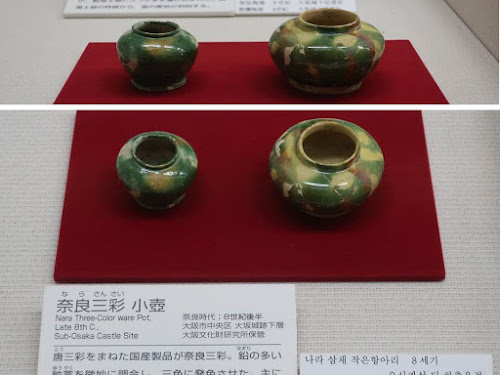 |
| Three color ware pots |
【Medieval era、中世】
The theme of the 9th floor
was “The Age of the Great Distribution Center and The Age of Osaka Honganji
Temple”. Osaka during the medieval era was shown here.
9階は「天下の台所の時代・本願寺の時代」。展示室は大きい。
 |
| The towns and roads in Osaka area、中世大阪の主な町 |
This is a model of Goeido (Icon Sanctuary) of the Osaka Hongan-ji temple in 1561. This temple had great social and religious influence. Osaka was developed under Honganji in the medieval era.
大坂本願寺の御影堂復元模型。中世の大阪は本願寺の寺内町として発達した。本願寺は難波宮、大阪城とほぼ同じ場所にあった。
 |
| Osaka Hongan-ji temple |
The photo below shows the model of a typical
street in Sakai in 1568. Christian missionaries walked on the street. Sakai was
not ruled by war lords. Many merchants lived there, and they traded with
foreign countries. I guessed it was a rich city, but houses were rusty.
信長が税を課した1568年の自治都市・堺である。思ったより貧相な街並みだ。
Hirano was an autonomous city like Sakai. The photo below was Ema board which was offered to
Kumata Shrine in Hirano by the merchant in 1627. He traded with Philippines and
Thailand.
自治都市・平野の末吉家が杭全(くまた)神社に奉納した末吉船の絵馬。フィリピンやタイと交易していたという。
The tools
of the rice planting rite of Kumata Shrine were shown below. It was a kind of
comedy show which was held at late night on the 13th of January. It was the end
of New Year holiday. The actor played
the farmer and used the hoe. He also fed the baby doll and made her to pee. The
baby doll was the symbol of the god of the rice field. It was called
“Ta-asobi”. “Ta” is a rice field and “asobi” is an entertainment. People must
have enjoyed overnight feast.
 |
| Ceremonial hoe and mask, replica |
杭全神社の御田植神事。正月13日の夜中から朝方にかけて行われた小正月の行事。農耕を狂言形式で演じ、面をつけたシテは鍬を入れたり、田の神と考えられる市松人形に食事や小便をさせるという。田遊びというらしい。正月休みを締めくくる遊びだ。
The picture
below is H. Toyotomi who was a war lord. He ruled not only Sakai and Hirano,
but also he ruled entire Japan. He built Osaka castle and stationed there.
 |
| 秀吉、大阪城天守閣所蔵 |
【Edo period、江戸時代】
 |
| Osaka in the Edo period, 江戸時代の大阪 |
In the Edo
period, Osaka was the Great Distribution Center of
Japan. Rice and the specialties were collected as a form of taxation. Those
were transported to Osaka and sold there, and then they were delivered across Japan. The
picture below shows the scene of the rice market in Dojima at the end of the
dealing time. The final rice price was sent to the other cities using flags. Future
trading was already practiced in Dojima.
江戸時代、大阪は天下の台所。下は、堂島の米取引の様子。米の価格は、旗で全国に伝えられる。
Rice was stored in the warehouses of daimyo war lords. The weight of the straw rice‐bag was 60kg, so workers were so strong. They used rice-notes
instead of rice itself when they dealt rice in the Dojima market.
蔵屋敷に米を運ぶ人々と米取引に使われた米切手。
 |
| Rice warehouse, Kura-yashiki、蔵屋敷 |
 |
| Rice-notes、米切手 |
Next picture shows the town of rice
warehouses. The picture depicted a cotton boat race. The fast boat arrived at
Edo in five days. Racing is a fun over the ages.
新綿を江戸に運ぶレース。みんなレースは好きだ。
The maximum
population of Osaka was about 400,000 in the Edo period (It is about three
million now). It was the second largest city in Japan.
 |
| Osaka in the late Edo period、江戸後期の大阪近郊地図 |
Senba was the name of the downtown. There
were many merchant houses. The imported goods shop was depicted. Everyone seemed
to be so busy and happy.
商人の町、船場。輸入雑貨店の唐物屋が描かれている。
 |
| Imported goods shop、からもん屋 |
The town-scope of Senba is shown
below. This model restored Senba in the mid 19th century. There were many big
houses with kawara ceramic roofs which were fire-proof.
It was a congested town, but people would have
felt broad sky and breeze when they were on the balconies. A gentleman relaxed
in his small back-yard.
Next picture shows you the
Hachikenya port which was the starting point of the boats to Fushimi, Kyoto. The
boat was called “Sanjyu-koku bune” which meant the maximum carrying capacity of
the boat was 4.5 tons. The passenger capacity was 28. The boat trip was fun for
people; it is exhibited in Kagiya museum in Hirakata.
The red-light district was depicted on this
folding screen which was made in the 18th century. People enjoyed
boat riding, parties and so on.
Next picture
shows that people gathered riverside to enjoy the evening breeze. There were a
lot of canals and rivers at that time. They seemed to relax and enjoy talking
each other. Most canals were filled in nowadays.
 |
| 大川涼み |
There
were many show businesses in Osaka such as Kabuki and puppet show which were
held at Doutonbori. Comedies and plays were performed in the ground of shrines
and temples. Audience supported the stars and bought their printings. It has
been forever fun. It was a point that people in Osaka had enough money to enjoy
the shows.
道頓堀の歌舞伎と人形浄瑠璃、社寺での芝居や寄席など多彩な興行が行われていた。見る側にも、贔屓連中や芝居絵などが流行って行った。今も変わらぬ楽しみである。人々にも余裕ができたということだ。
 |
| The list of the Kabuki actors in 1835 浪速役者重宝鑑(天保6年) |
The printing below shows that fans
welcomed the Kabuki actor Shikan in 1815. Shikan was getting on the big boat.
Shikan returned from Edo and he would go on the stage to fans.
Kabuki (YouTube) https://www.youtube.com/watch?v=JRznKiTXp6k
Kabuki (YouTube) https://www.youtube.com/watch?v=JRznKiTXp6k
江戸から戻った芝翫(三代目中村歌右衛門)の迎え船。歌舞伎はいつも人気だ。
芝翫は本当に千両を稼いだトップスター。江戸の中村座と三年契約を結んだが、二年目の1815年に病気を理由に帰阪(下の絵の大歓迎)。しかし、江戸の町奉行所に訴えられて、1818年に江戸に戻り、契約の二年務めるが、大入りだったとのこと。その後は、大阪に戻り舞台を続けた伝説の千両役者だ。
 |
| Wood-block print book depicting Kabuki actors in the 19th century 上方役者絵貼交帖(19世紀) |
The model of a big theater called
Kado theater is shown below. Wealthy people arrived at the tea house by boat.
They had tea and bought lunch boxes, then went to the theater. It was really
joyful for boy servants to follow their masters to see the Kabuki play.
お大人は舟で茶屋につき、弁当をもらって芝居を見に行ったという。お供する小僧さんには大きな楽しみだったようた。
The puppet show which is called Ningyo-jyoururi or Bunraku was popular too. It is elegant art nowadays, so some performers are designated as the intangible cultural assets.
Bunraku (YouTube) https://www.youtube.com/watch?v=1qcBSAwQVpw
Pupils were interested in the operation of the puppet.
 |
| Inside the Kado theater in 1838、角の芝居(旧角座) |
 |
| Kado theater in the old picture |
The puppet show which is called Ningyo-jyoururi or Bunraku was popular too. It is elegant art nowadays, so some performers are designated as the intangible cultural assets.
Bunraku (YouTube) https://www.youtube.com/watch?v=1qcBSAwQVpw
 |
| 人形浄瑠璃・文楽の人形他 |
Religious practice: People worshiped
shrines and temples. They went there on the En-nichi days and the
festival days. Those were annual events. People enjoyed one day trip to the
shrine or the temple. The travel(The history of travel of Japanese ordinary people) to the shrine or the temple in the
remote area was great fun for people. Visiting shrines and temples was a good entertainment
at that time. The outdoor party was held in front of Sumiyoshi Shrine which is
near my parents’ house.
 |
| Ikutama Shrine、生玉神社 |
 |
| Sumiyoshi Shrine in the early 19th century、江戸後期の住吉大社 |
 |
| Sumiyoshi Shrine、住吉大社 |
 |
| Drum bridge、太鼓橋 |
 |
| Lighthouse Takatourou、高灯篭 |
 |
| Folding screen with picture of Sumiyoshi Shrine 住吉社頭図屏風 |
信仰について。人々は社寺などに祈願し、縁日や祭礼に詣でるなど様々な信仰生活を営んできた。これらは、年中行事となり、近郊の行楽として、また、遠方の社寺参詣は旅行(庶民と旅の歴史)として人々の楽しみにもなっていった。と書かれていた。社寺参詣は楽しみである。実家に近い住吉大社の前の浜では、宴会が催されている。高灯篭は再建されている。
En-nichi festivals were held in
front of shrines and temples. The photo below was a raree show. When you peep
through the hole, you can see the picture, and the performer tells the exiting
story. It was popular until WW2.
The sign board of the restaurant was
exhibited. It was famous for the miso-paste with tai fish meat. Interestingly
enough, there were restaurant guide books at that time, and this restaurant was written in it. There were foodies over
the ages.
The picture
below shows clay miniature dogs, which were
found under the Osaka castle. Dogs have a
lot of babies, so it was written that miniature dogs would be talismans of safe
delivery. They were so cute.
Watanabe
village near Osaka was the center of leather industry. Leather of cows and
horses were used the material of winter shoes and drums. The shoes in photo
were used in daily life. I don’t know we Japanese wore leather shoes. The material of the old Japanese footwear were wood or straw. I’d like
to know whether it was comfortable or durable.
Enthusiastic
travel to Ise, “Okage-mairi” : Those happened in 1830 and 1867 here. The
trigger of Okage-mairi was a strange topic such as talismans of the shrine
falling down from the sky. People would have needed a good vent to escape from everyday
life.
In the picture below, the talismans which were said to
have descended from the sky in 1867 were recorded. We can know the shape, time
and place where talismans dropped down. No one believes it now of course.
 |
| Talismans which came from the sky in 1867 |
【Modern Osaka、近現代の大阪】
In the 8th
floor, Osaka before WW2 was exhibited. Crafts were beautiful.
 |
| Small knife made by Mr. Sakai in 1975 鷹図二所物(ふたところもの) |
 |
Satsuma Porcelain bowl and vase with design of plum arabesque and flowers, made by Mr. Yabu in the late 20th century 梅唐草紋の茶碗と花瓶、明治20年代、藪明山作 |
 |
| Dancer’s fans |
 |
| Small furniture of Konoike family which was the richest family in Osaka、鴻池家の生活用具 |
Everyday life of the people were very vivid. I think it
was a good time for Japan, all people worked hard in order to improve our lives
and catch up western countries.
庶民の暮らしは活気がある。みんな生活の向上を実感しながら、西洋のレベルを目指して頑張っていたのだろう。
 |
| Wet market in the early 20th century 大正時代の本庄公設市場 |
 |
| Tenjin-Kou for Tenjin festival、天神祭での天神講 |
The picture
below is a geological section under the Osaka castle. There was relic of the
Osaka internal war in which Tokugawa attacked and destroyed the Toyotomi family.
I am interested
in the sand or something have accumulated on the surface of the 17th
century. The thickness was more than 1 m, my question is how people maintained
houses. The sand accumulated about 3 cm every year. It is mysterious to me.
大阪城の地層模型があったが、京都文化博物館の展示と同じく、17世紀の地表面は1m以上下にある。この間に塵埃が積もることもすごいが、一年に数センチ積もるとなると家はどうしていたのか。不思議だ。
 |
| Geological section under the Osaka castle、大阪城下の地層 |
This museum
taught me the history of Osaka using many models, videos and exhibits. I felt
the energy of people in Osaka here.
展示の量が多く、大阪人の活気を感じる博物館であった。
27 funs(楽Fun) were found. Visited in June, 2018
http://www.mus-his.city.osaka.jp/eng/index.html, accessed in August, 2020
Previous post (Museum in old capital Kyoto
which is just 50km away from Osaka) :
Next post (Museum in Osaka about ordinary
people’s life) :Osaka
museum of Housing and Living 大阪くらしの今昔館



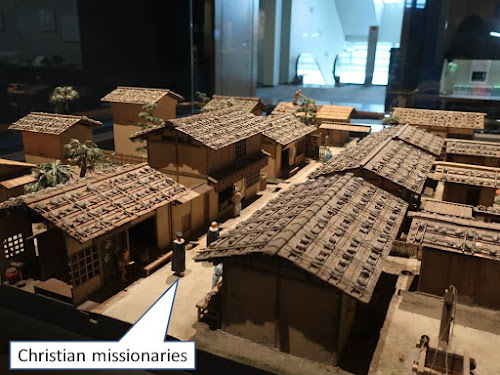

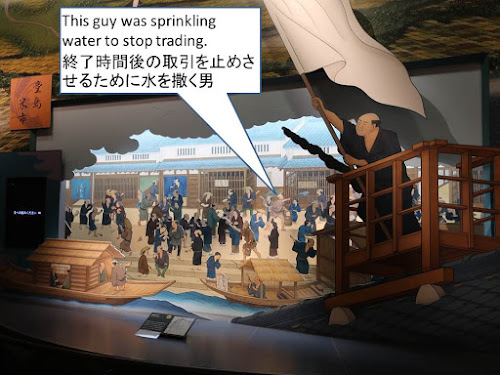









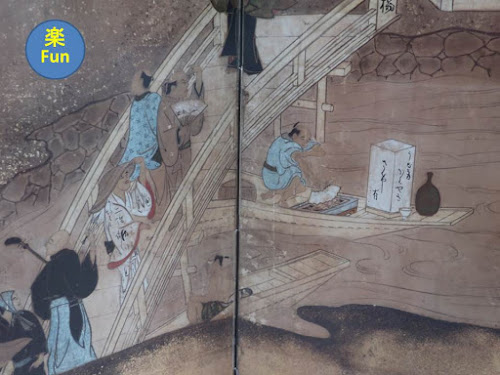









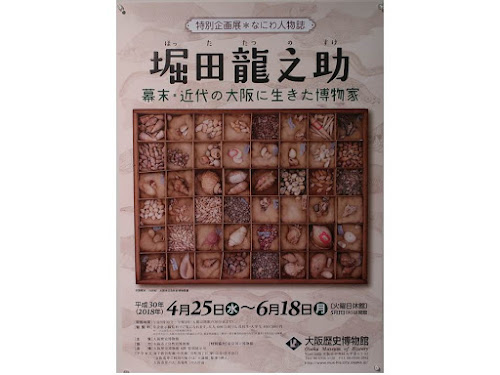
Comments
Post a Comment